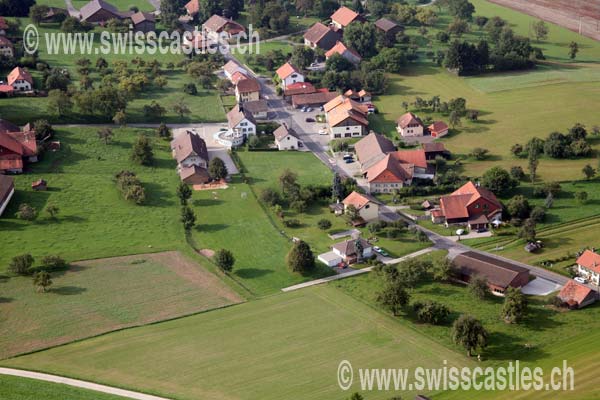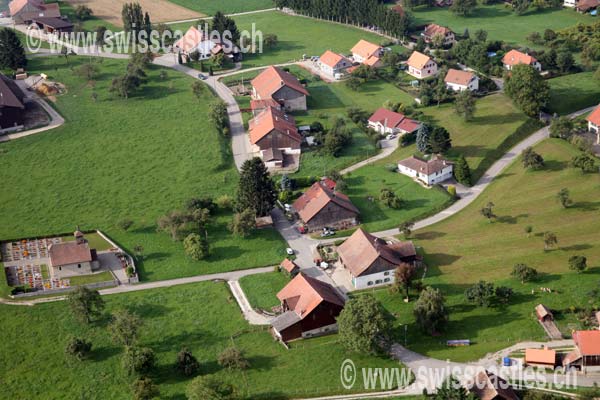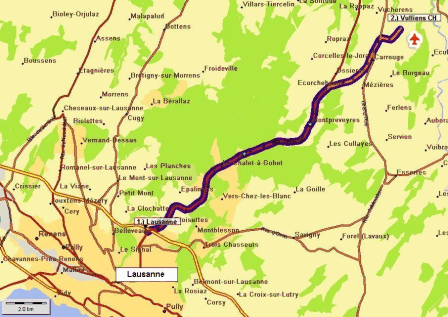Vulliens
Vulliens
Vulliens is a municipality in the district Broye Vully the canton of Vaud in Switzerland.
Geography
Vulliens is located on 708 m above sea level. It is 25 km southwest of the district town Payerne ( straight line ). The village is located on a slightly inclined to the west plateau, between the valleys of Carrouge and Broye, in the Vaud Mittelland.
The area of 6.6 km ² large municipality area includes a portion of the Molassehügellandes between the Jorat and the upper reaches of the Broye. The northern border is formed by the deeply cut into the Molassehöhen Broye valley south of Moudon and the mouth of the Bressonne in the Broye. From here, the communal land M. extends south on the ridge of Vulliens with the Pierravau ( 696 m above sea level. M. ), the amount of Bramafan ( 768 m above sea level. M. ) and Le Signal ( 776 m above sea level., The highest point the community). The ridge falls steeply to the east relative to Broyetal, while he only gently slopes to the west, before a steep drop occurs for Carrougetal. The erosion of Carrouge forms for long stretches the western boundary of Vulliens. At the southernmost territory extends in the Bois de Ban. From the municipality surface 1997 4 % related to settlements, 27 % of forest and shrubs, 68 % to agriculture and about 1% was unproductive land.
To Vulliens include the hamlet Bressonnaz -Dessus (570 m above sea level. M. ) on the hillside above Broyetal, Sépey ( 645 m above sea level. M. ), Bramafan ( 688 m above sea level. M. ) and Champ du Fau (711 m above sea level. M. ), all at the height of Vulliens as well as several individual farms. Neighboring communities of Vulliens are Ferlens, Carrouge, Vucherens, Syens Moudon and Chavannes -sur -Moudon in the canton of Vaud and Montet ( Glâne) and Ecublens in the Canton of Fribourg.
Population
With 424 inhabitants ( 31 December 2012) Vulliens one of the small communities of the Canton of Vaud. Of the 94.5 % inhabitants are French-speaking, German-speaking 3.4 % and 0.5 % Italian-speaking (as of 2000). The population of Vulliens amounted in 1900 to 444 inhabitants. Thereafter, through constant migration to 1970 recorded a decrease to 266 inhabitants; Since then, the population grew significantly again.
Economy
Vulliens was until the second half of the 20th century, mainly coined by farming village. Even today, the crop and livestock farming have an important place in the economic structure of the population. More jobs are in small local manufacturing and services available. Through the construction of several single-family homes in the past few decades, the village has developed into a residential community. Many workers are therefore commuters who work in the surrounding larger towns.
Traffic
The community is located off the major thoroughfares, but is easily accessible from Moudon. Through the bus line 62, the Transports publics de la région Lausannoise that runs from Lausanne to Moudon, Vulliens is connected to the public transport network.
History
The territory of Vulliens was already inhabited in Roman times, as evidenced by findings of Gallo-Roman tombs. The first written mention of the village was carried out in 1142 under the name Wilens. Later the names of the Will ( 1154 ) published, Willeyns ( 1160 ), Vill One ( 1184 ), Vulens ( the 12th century ), Vulleins ( 1220 ), Willayns ( 1264 ), Vylliens and Wyliens (1331 ) and Vuilliens and Williens in 14. century. The name goes back to the Burgundian people named Willa and means for the people of Willa.
In the Middle Ages Vulliens formed a significant manor, which included the villages Carrouge, Mézières, Ropraz and Chapelle (Glâne ). A part of their property on left the Lords of Vulliens in the 12th century the newly founded Cistercian abbey skin - Cret. In the 13th century the rule came under the sphere of influence of the Savoy. By inheritances, the rule reduced the late 13th century and subsequently underwent numerous changes in ownership.
With the conquest of Vaud by Bern in 1536 Vulliens came under the administration of the bailiwick Moudon. After the collapse of the ancien régime, the village belonged from 1798 to 1803 during the Helvetic Republic to the canton of Geneva, who came up then with the enactment of the Act of Mediation in the canton of Vaud. 1798 was assigned to the District Oron.
Attractions
Already in 1228 a parish church is mentioned in Vulliens. The present building has very little in common with the medieval church; the only parts preserved are two windows and the portal from the 15th century. Dating from the 18th century Château du Sépey, a former manor house that has a tower dating from the 12th century. It was occasionally the residence of the painter Eugène Burnand.









